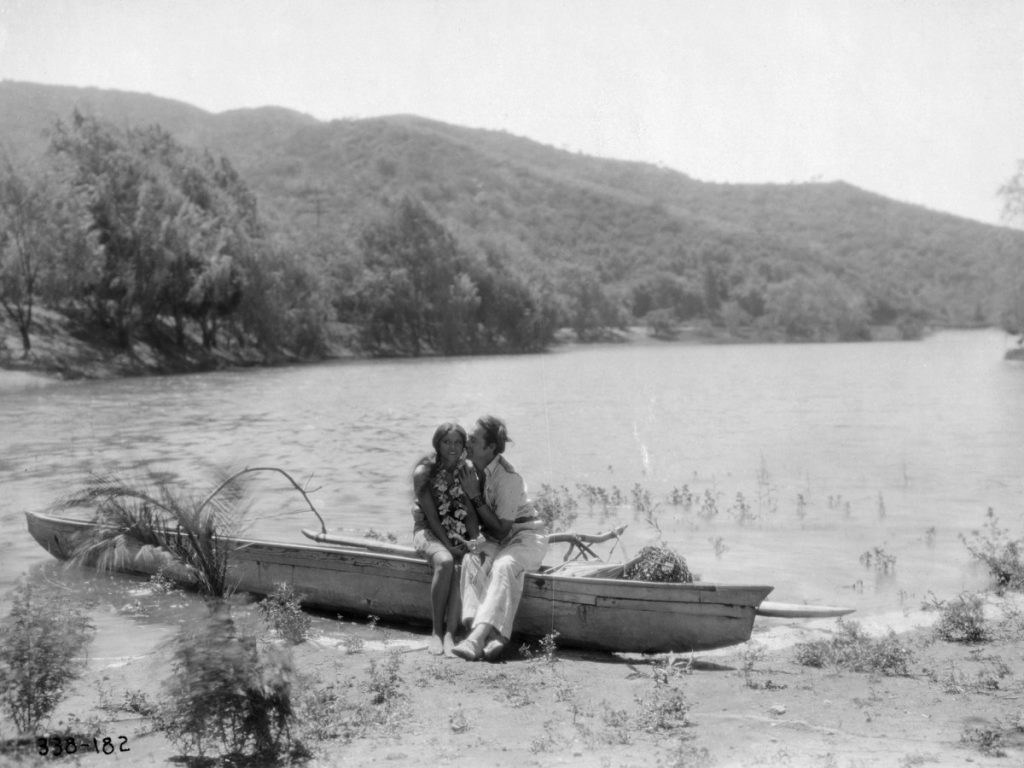Patrick Holzapfel
– “The main aim of each project of preservation of the moving image is therefore, strictu sensu, an impossible attempt to stabilise a thing that is inherently subject to endless mutation and irreversible destruction.“ (from Paolo Cherchi Usai, The Death of Cinema, 2001)
– Bringing the famous and legendary White Shadows in the South Sea (1928) directed by W.S. Van Dyke and Robert J. Flaherty (who left the project) as a gift, the George Eastman Museum not only chose a unique print for presentation but also one that talks about the inevitability, beauty, tragedy and necessity of decay in film history
– During the third act of the film scratches and tears made the captivating melodramatic story almost disappear behind the medium. In a scene in which protagonist Dr. Matthew Lloyd, a doctor struggling with the capitalistic and white exploitation of Indigenous peoples is getting closer to Fayaway, a protected woman of the community he lives with, we could hardly see what was going on through the traces of the copies’ history.
– More than once I felt that the film could disappear before my very eyes. The end of a civilization strangely merged with the end of cinema. It added to the experience of watching the film. – Here come two more quotes from Paolo Cherchi Usai’s (senior curator of motion pictures at the George Eastman House) seminal thoughts in The Death of Cinema:
“Conceived in those terms, the effort to preserve a moving image in the state in which it was found (plus making it viewable to others, once the loss of information deriving from the process has been acknowledged) has at least some chance of being useful by fostering the concept of durability, its potential and its limitations. A vain effort it is, but also one that is fertile in its implications. Preservation of the moving image is a necessary mistake.“
“Moving image preservation will then be redefined as the science of its gradual loss and the art of coping with the consequences, very much like a physician who has accepted the inevitability of death even while he continues to fight for the patient’s life.“

– As Jurij Meden, curator of the Austrian Film Museum and formerly curator of film exhibition at the George Eastman Museum revealed in his introduction, a nitrate print came from an anonymous donator in the 1950s and was preserved in 1989.
– The film looked absolutely stunning. This not only refers to the copy but especially to the awarded cinematography of the film by Clyde De Vinna. A sequence with pearl divers struggling for their life shot underwater will stay with me for a very long time.
– The idea for the film came from production legend Irving Thalberg who worked as Production Manager for MGM from the age of 25. There are different stories about how Van Dyke and Flaherty came to the project as a rather unlikely director’s duo. In my opinion the most likely story is that Thalberg had two directors in mind for the film from the very beginning. Flaherty expert and film historian Richard Barsam notes that Thalberg first tried to persuade John McCarthy to direct together with Flaherty. McCarthy refused to co-direct and W.S. Van Dyke took over.
– When the director who went on directing Tarzan the Ape Man (1932) met with the director of Nanook of the North (1922) a clash was inevitable. Flaherty felt that the big team, listening to music from the Coconut Grove sitting under real coconut trees, was inappropriate to film the communities on the Polynesian islands.
– Yet, in the final film traces of Flaherty are clearly visible. For example, there is a fascinating sequence in which an octopus is caught and later we witness the preparation of a meal. The result of the finished work is a problematic but very complex exotica, somehow torn between its moral stance and earnest curiosity as well as a desire to sell the otherness of the place to a Hollywood audience.
– Writer Frederick O’Brien whose travel impressions of the same name as the film already inspired Flaherty’s Moana (1926) was an acquaintance of Flaherty. Nevertheless the director first tried to persuade Thalberg to adapt Herman Melville’s Typee: A Peep at Polynesian Life instead.
– It is a story of Paradise/Paradise (Lost).
– A white shadow is a mesmerizing metaphor for the exploitation and greed fueled by shining pearls. In a great scene one of the inhabitants of the islands shows the doctor how he produces fishing hooks from the collected shells. When he finds a pearl in the shell he looks at it with utter indifference and throws it in the sand. At the same time a devilish light appears in the eyes of the Doctor. Sneakily he puts the pearl into his pocket and later starts a fire of destruction. His actions are motivated by greed and they lead to a second white shadow very well known to all of us: Regret.
– When a mysterious ship appears on the horizon and with one sudden movement strikes its white sails we know that this is the story of ghosts, of cultures vanishing and the legends of the sea; it is a film about a last glimpse made with the fierce belief in the endurance of Americanized emotional sensibilities. Paradoxically, as long as the latter exist, we are able to feel the loss and injustice of history.
More on Forever Film
Notes on Grauzone (1979, Fredi M. Murer)
Notes on Film and Reality (1942, Alberto Cavalcanti and Ernest Lindgren)